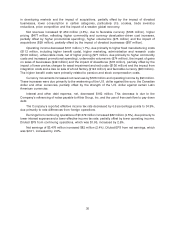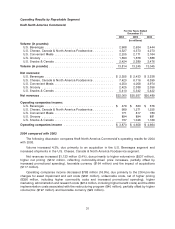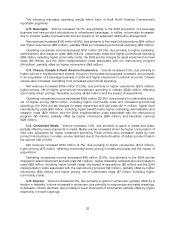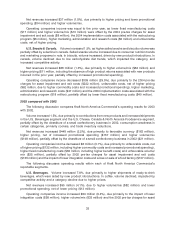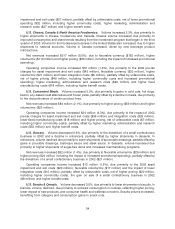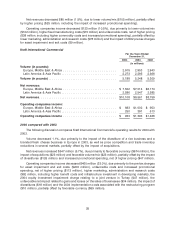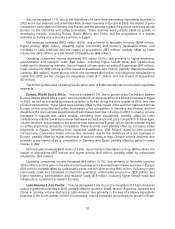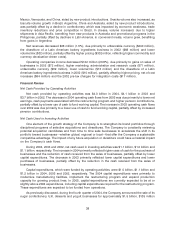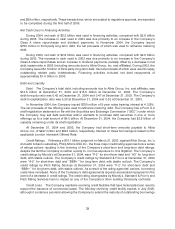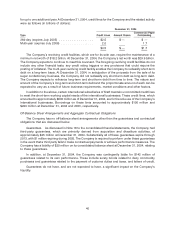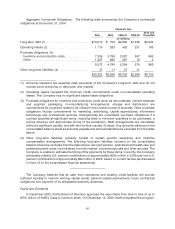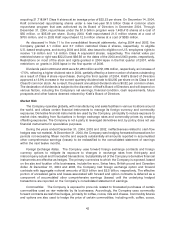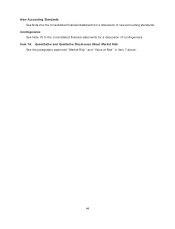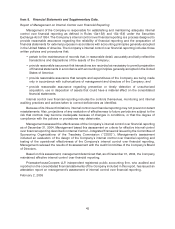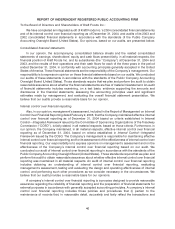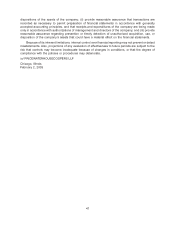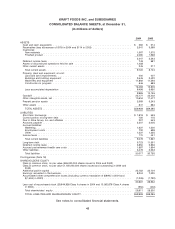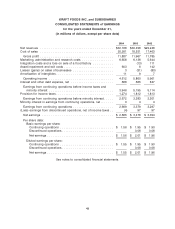Kraft 2004 Annual Report Download - page 40
Download and view the complete annual report
Please find page 40 of the 2004 Kraft annual report below. You can navigate through the pages in the report by either clicking on the pages listed below, or by using the keyword search tool below to find specific information within the annual report.and $59 million, respectively. These transactions, which are subject to regulatory approval, are expected
to be completed during the first half of 2005.
Net Cash Used in Financing Activities
During 2004, net cash of $3.2 billion was used in financing activities, compared with $2.8 billion
during 2003. The increase in cash used in 2004 was due primarily to an increase in the Company’s
Class A share repurchases and dividend payments. In November 2004, the Company issued
$750 million in third-party long-term debt, the net proceeds of which was used to refinance maturing
debt.
During 2003, net cash of $2.8 billion was used in financing activities, compared with $2.6 billion
during 2002. The increase in cash used in 2003 was due primarily to an increase in the Company’s
Class A share repurchases and an increase in dividend payments, partially offset by a decrease in net
debt repayments in 2003 (including amounts due to Altria Group, Inc. and affiliates). During 2003, the
Company issued $1.5 billion of third-party long-term debt, the net proceeds of which were used to repay
outstanding related party indebtedness. Financing activities included net debt repayments of
approximately $1.4 billion in 2003.
Debt and Liquidity
Debt. The Company’s total debt, including amounts due to Altria Group, Inc. and affiliates, was
$12.5 billion at December 31, 2004 and $13.5 billion at December 31, 2003. The Company’s
debt-to-equity ratio was 0.42 at December 31, 2004 and 0.47 at December 31, 2003. The Company’s
debt-to-capitalization ratio was 0.30 at December 31, 2004 and 0.32 at December 31, 2003.
In November 2004, the Company issued $750 million of 5-year notes bearing interest at 4.125%.
The net proceeds of the offering were used to refinance maturing debt. The Company has a Form S-3
shelf registration statement on file with the Securities and Exchange Commission (‘‘SEC’’) under which
the Company may sell debt securities and/or warrants to purchase debt securities in one or more
offerings up to a total amount of $4.0 billion. At December 31, 2004, the Company had $3.5 billion of
capacity remaining under its shelf registration.
At December 31, 2004 and 2003, the Company had short-term amounts payable to Altria
Group, Inc. of $227 million and $543 million, respectively. Interest on these borrowings is based on the
applicable London Interbank Offered Rate.
Credit Ratings. Following a $10.1 billion judgment on March 21, 2003, against Altria Group, Inc.’s
domestic tobacco subsidiary, Philip Morris USA Inc., the three major credit rating agencies took a series
of ratings actions resulting in the lowering of the Company’s short-term and long-term debt ratings,
despite the fact the Company is neither a party to, nor has exposure to, this litigation. The Company’s
credit ratings by Moody’s at December 31, 2004, were ‘‘P-2’’ for short-term debt and ‘‘A3’’ for long-term
debt, with stable outlook. The Company’s credit ratings by Standard & Poor’s at December 31, 2004
were ‘‘A-2’’ for short-term debt and ‘‘BBB+’’ for long-term debt, with stable outlook. The Company’s
credit ratings by Fitch Rating Services at December 31, 2004 were ‘‘F-2’’ for short-term debt and
‘‘BBB+’’ for long-term debt, with stable outlook. As a result of the rating agencies’ actions, borrowing
costs have increased. None of the Company’s debt agreements requires accelerated repayment in the
event of a decrease in credit ratings. The credit rating downgrades by Moody’s, Standard & Poor’s and
Fitch Rating Services had no impact on any of the Company’s other existing third-party contracts.
Credit Lines. The Company maintains revolving credit facilities that have historically been used to
support the issuance of commercial paper. The 364-day revolving credit facility expires in July 2005,
although it contains a provision allowing the Company to extend the maturity of outstanding borrowings
39



